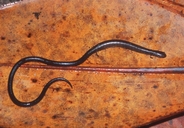Description of a New Species of OEDIPINA from Panamá
Oedipina maritima n. sp. Maritime Worm Salamander --Salamandra marítima
Holotype
USNM 529981, an adult female from Escudo Camp, West Point, Isla Escudo de Veraguas, Prov. Bocas del Toro, Panamá, approximate 9°6.1′N, 81°4.5′W, collected 28 March 1991, by R. I. Crombie.
Paratypes
USNM 529982–529985; USNM Field number 195536 (to be deposited in a collection in Panamá), MVZ 219997, same data as holotype; KU 116681, E end Isla Escudo de Veraguas, Prov. Bocas del Toro, Panamá, 4 m. elev.
 Esta es una foto de una salamandra del género Oedipina.
Esta es una foto de una salamandra del género Oedipina.Salamanders on Isla Escudo de Veraguas were collected in decaying fronds and associated moist litter near a fallen palm in a coconut palm grove in late March, 1991. The eggs were found inside a pile of coconut trash at the base of a tree (Terminalia) on the beach at Guayami Settlement, SE part of island, less than 5 m from the ocean.
Comment
Oedipina maritima does not resemble O. alleni in morphology (it is more slender and has a narrower and more pointed head, and it generally lacks dorsal light coloration), and it is very distinct in its DNA sequences. It differs from O. parvipes from central Panamá profoundly in DNA sequences (4.8–4.9% for 16S, 7.8–8.1% for cyt b), but appears to differ otherwise only in coloration (we have no allozyme data). However, we also note that evidence of conspecificity of Panamanian and Colombian populations of O. parvipes is weak, and A. H. Brame Jr. and D. B. Wake have long planned to undertake a detailed analysis of this question once adequate material is available. Accordingly, we decided to describe what is clearly an independent taxon at this time and reserve a complete analysis of Panamanian and South American members of this genus to a later date.
This species is known only from Isla Escudo de Veraguas. If it is restricted to this island, it is the only tropical salamander that is endemic to an island. At least three species of this genus occur on the adjacent mainland, two of which appear to be undescribed. KU 116682, a 17.5 SL juvenile from the mouth of Rio Cahuita, Prov. Bocas del Toro, Panamá, 1 m. elev., cannot be classified with certainty but may be assignable to O. maritima.
Etymology
The name maritima is derived from maritimus (L), meaning of the sea, in reference to the type locality of this species on a low-lying island in the Caribbean Sea
This species is known only from Isla Escudo de Veraguas. If it is restricted to this island, it is the only tropical salamander that is endemic to an island.
No hay comentarios.:
Publicar un comentario